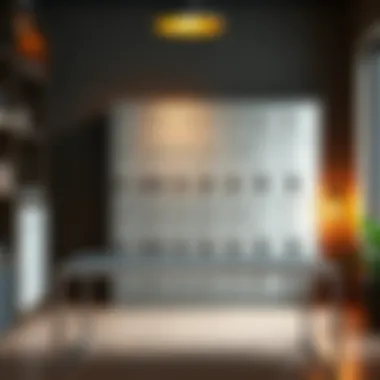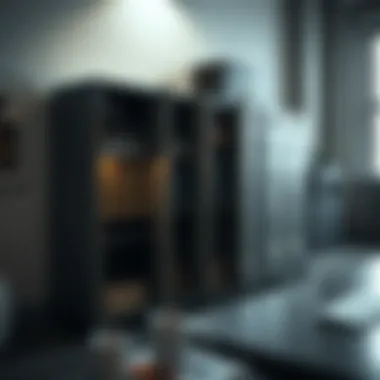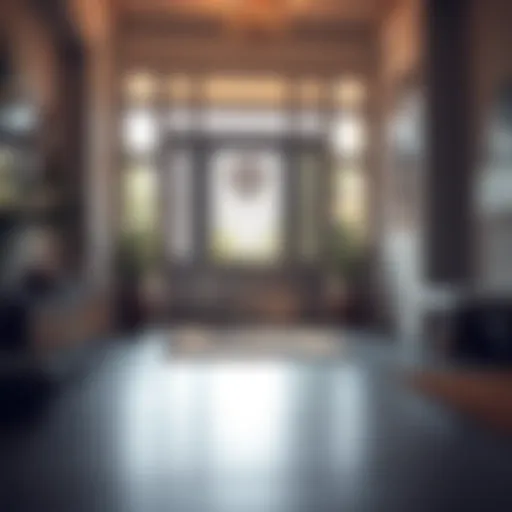The Ultimate Guide to Desktop Locking Cabinets


Intro
In a world where personal and professional environments are constantly evolving, having a secure and organized workspace is more essential than ever. Desktop locking cabinets offer a solution that blends security with simplicity, making them a must-have for both homes and workplaces. These cabinets not only provide safety for important documents and digital devices but also help declutter your workspace. In this comprehensive guide, we will delve deeply into the realm of desktop locking cabinets, discussing their design, security features, and the impact they have on workspace organization.
Outfitting your workspace with the right storage solution is more than just a functional consideration; it's also about aesthetics. Whether you're a homeowner looking to enhance your home office, a designer curating an appealing workspace, or a retailer choosing the right product for your customers, understanding the options available is paramount. We will explore various styles, modern trends, and maintenance tips, equipping you with the knowledge to make informed choices.
This guide is crafted with you in mind, targeting homeowners, designers, retailers, enthusiasts, and DIYers. We aim to present the essential points of consideration so you can navigate the complexities of desktop locking cabinets with ease. From the emerging trends in eco-friendly materials to innovative security features, there's a lot to unpack.
So grab a seat as we set off on this informative journey.
Understanding Desktop Locking Cabinets
Desktop locking cabinets serve not just as an afterthought in workspace design but are fundamental to shaping a secure and organized environment. With the rise of hybrid workspaces and an increase in remote working, these cabinets have gained importance like never before. They offer a tangible solution to the frequent problem of managing personal and sensitive documents in a way that blends seamlessly into one’s working area.
Definition and Purpose
At the core, a desktop locking cabinet is a storage solution designed to secure items such as documents, electronics, and personal belongings. These cabinets typically feature a locking mechanism to prevent unauthorized access, which makes them an essential asset for both home and office environments. The purpose extends beyond mere storage; they also help in maintaining confidentiality and can serve as a practical tool in promoting a disciplined workspace.
For example, having a dedicated space for sensitive information not only protects against potential data breaches but also promotes productivity. Imagine having all your important paperwork tucked away behind a lock, ensuring that the only people with access are you and anyone you choose to share that access with.
Historical Context
If we take a step back in time, the concept of locking cabinets isn’t as new as one might think. The roots can be traced back centuries to when early forms of storage were crafted to safeguard valuables. In those days, locking cabinets weren’t just practical; they were symbols of security and authority, often found in the homes of the wealthy or in establishment offices.
By the 19th century, as businesses began to flourish, particularly in places like the United States and Europe, the design of locking cabinets evolved to meet the burgeoning needs of storage security. These developments coincided with the industrial revolution, where the increasing flow of cash and constants changes in business could lead to loss without proper storage solutions.
Fast forward to the modern era, and you find locking cabinets now represent both innovation and style. High-quality materials like metal and eco-friendly options are now available, reflecting the contemporary focus on sustainability. Consumers today aren’t just looking for a secure option—they want something visually appealing that complements their workspace aesthetic.
"Desktop locking cabinets are no longer just about security; they’re about creating an organized identity in our increasingly chaotic world."
Importance of Security in the Workspace
In an age where information is as valuable as gold, the safety of your workspace has never been more crucial. Whether in a bustling corporate office, a home office, or a learning environment, the security of sensitive materials is paramount. Desktop locking cabinets serve as a primary line of defense against unauthorized access, ensuring that personal belongings or confidential documents are kept safe from prying eyes and hands. An awareness of the potential threats helps to shape security strategies and refine the functionalities needed in a locking cabinet.
Assessing Risks in Office Environments
Every office setting carries its unique risks that can compromise security. Identifying these risks is the first step towards mitigating them.
- Theft: This is the most apparent risk. Whether it’s a disgruntled ex-employee or an opportunistic visitor, the chance of theft is a concern in any shared workspace.
- Unauthorized Access: Files and electronics can be left vulnerable, especially in areas where multiple individuals have access to the same space. Internal risks often stem from colleagues who may inadvertently overlook security measures.
- Data Breaches: In today’s digital era, securing physical documents is just as important as cybersecurity. Paper files that contain sensitive information can easily be compromised if not locked away.
- Environmental Hazards: Risks aren’t solely human-made; factors like water damage or fire can impact stored items as well. A sturdy and well-constructed cabinet can often shield contents better than leaving them exposed.
As offices adapt to hybrid models and change layouts frequently, the assessment of each workspace's vulnerabilities should become a routine part of the security strategy.
Benefits of Locking Mechanisms
Employing robust locking mechanisms can significantly enhance the security of your desktop lockers. Here are some benefits of integrating effective locking solutions:
- Peace of Mind: Knowing that your personal items are securely stored allows individuals to focus better on their tasks, fostering a more productive work environment.
- Durability: High-quality locks are built to last, offering resistance against tampering and damage. Investing in better locks reduces the long-term costs associated with theft and replacement.
- Access Control: Different locking mechanisms, such as traditional key locks, digital keypads, or biometric options, allow for tailored access based on need. This ensures only authorized personnel can access sensitive items, making it easier to track who enters which cabinet.
- Integration with Smart Technology: Many modern locking cabinets can sync with security systems or mobile devices, adding another layer of protection. This tech-savvy approach lets users monitor access and receive notifications if the security of their cabinets is compromised.
"A safe workspace promotes a productive workplace, making the right locking mechanisms not just a choice, but a necessity."
Key Features to Consider
When it comes to selecting a desktop locking cabinet, understanding its key features is essential. These factors significantly contribute to your decision-making process, impacting both functionality and security. Properly assessing these elements helps in ensuring that the cabinet not only meets your organizational needs but also enhances the overall safety of your workspace. Characteristics such as materials, size, and locking mechanisms can dictate how effective the cabinet will be in your specific environment. Furthermore, considering these features can assist not just homeowners but also designers and retailers in better serving their clientele.
Material Choices
Metal vs. Wood
Choosing between metal and wood for a locking cabinet is like picking between apples and oranges; they each have distinct advantages catering to different preferences. Metal cabinets, for instance, are often more robust and resistant to damage from daily wear and tear. They’re also easier to clean, which brings a practical advantage in environments like corporate offices where cleanliness is key.
On the other hand, wood cabinets offer a warmth and aesthetic appeal that can charm any home office or study. The unique grain patterns in wood can bring character to a workspace that metal cannot. However, wood can be more susceptible to scratches and dents compared to metal. Still, for those looking for a cabinet that compliments a rustic or classic design, wood remains a favored choice.
Eco-Friendly Options
In an era where sustainability matters more than ever, eco-friendly options are taking center stage in the world of desktop locking cabinets. Cabinets made from recycled materials or sustainable wood sources can reflect a commitment to the environment, appealing particularly to a conscientious buyer.


These options often come with certifications from organizations ensuring that materials are responsibly sourced, adding to their appeal. However, potential buyers should be cautious; not all eco-friendly cabinets offer the same sturdy construction as their conventional counterparts, requiring careful selection to ensure durability.
Size and Capacity
Compact versus Full-Size Models
When selecting a locking cabinet, size undoubtedly matters. Compact models are increasingly popular in today’s smaller workspaces. They fit easily into tight corners or under desks while providing adequate storage for essentials like documents and small electronics. This compactness often does not compromise on security. However, compact models may limit the amount of storage available, which could be a disadvantage for users needing significant storage space.
Conversely, full-size cabinets can accommodate larger items and more extensive paperwork. They can often house multiple compartments or shelves, providing a versatile solution for bustling environments such as corporate offices or classrooms. While they take up more floor space, their extra capacity can serve schools and larger design firms exceptionally well.
Customization Options
Customization can be the glue that holds the practical and aesthetic elements of a cabinet together. Flexibility in design allows homeowners and organizations to tailor cabinets that suit their specific needs and tastes. This could include adjustable shelves, drawer configurations, and color choices that can blend seamlessly into existing decor.
While it may come at an additional cost, the benefits of having a cabinet that meets unique requirements far outweigh the drawbacks. Customization ultimately leads to both better organization and a more harmonious workspace environment.
Locking Mechanisms
Traditional Key Locks
Among the simplest yet most effective security measures are traditional key locks. They provide a straightforward approach to safeguarding your belongings, and the tactile familiarity of a key can be comforting for many users. Despite advancements in technology, key locks remain popular for their reliability and ease of use.
However, they are not without their pitfalls. Losing a key can result in access issues, and some might argue that this mechanism may not provide the highest level of security compared to modern alternatives. Understanding the context in which they will be used is crucial when making a choice.
Digital and Biometric Solutions
In contrast to traditional methods, digital and biometric solutions represent the cutting edge of locking cabinet technology. These systems often offer advanced security features, including fingerprint recognition and numeric keypads, thus providing quick and easy access without the need for physical keys.
What sets these systems apart is their capacity to integrate with existing security setups, offering an additional layer of safety through personalization. Yet, potential downsides include the risk of electronic failure and the need for power sources, raising questions about reliability in critical moments. Therefore, it remains vital that users consider their own comfort levels and the specific environment when choosing these advanced locking mechanisms.
Desktop Locking Cabinets in Different Settings
Understanding the various settings where desktop locking cabinets are used offers insight into their utility and necessity. These cabinets are not "one-size-fits-all" but rather tailored solutions that cater to the specific needs of diverse environments. Whether it is a home office, a corporate space, or an educational institution, the design, material, and locking mechanisms can vary greatly, impacting not just security but also the overall organization and efficiency of the workspace.
Home Offices
In today’s world, many professionals are working from home, making the home office a crucial space. Desktop locking cabinets serve as a safeguard for documents and gadgets that need to be secure yet accessible. With the increase in home office setups, a significant consideration is the balance between aesthetic appeal and security.
- Space Optimization: Many home offices may have limited space, and the locking cabinet must be compact yet functional. A slim design that can fit under a desk or in a corner without taking up too much room can help in maintaining an organized environment.
- Personal Security: In a home office, personal security is vital. High-quality locking mechanisms protect sensitive information from unauthorized access, making it critical for freelancers, consultants, and remote workers, whose documents may include confidential client information.
- Style Contribution: The choice of material, be it metal or wood, influences the decor and can complement the home’s style. An aesthetically pleasing cabinet adds to the workspace’s charm.
Corporate Environments
In corporate settings, desktop locking cabinets are essential for protecting company assets and sensitive information. They play a pivotal role in maintaining workplace discipline, especially in shared office spaces where employees may not have dedicated desks.
- Confidentiality Assurance: Many corporations deal with sensitive data, be it financial reports or employee files. Locking cabinets help ensure this information remains confidential, satisfying legal obligations and protecting the company’s reputation.
- Simplified Organization: Shared desks can lead to clutter. Locking cabinets provide a designated space for each employee's belongings, reducing the chances of lost items and enhancing overall organization. With the right layout, the office can become more efficient and polished.
- Compliance with Regulations: Many industries are governed by strict data protection laws. Implementing proper storage solutions can assist in compliance and mitigate risks associated with data breaches.
Educational Institutions
Schools and universities have diverse needs concerning security and organization. Desktop locking cabinets serve as an important resource in this setting, aiding both in the management of supplies and the safeguarding of sensitive materials.
- Resource Management: In educational settings, different departments may have various resources that need protecting, such as test materials or educational aids. Locking cabinets can ensure that only authorized personnel have access to these materials, promoting fair use and accountability.
- Student Privacy: In colleges, students often store personal belongings, academic records, or even technological devices in shared spaces. Locking cabinets provide a sense of security, allowing students to focus without worrying about theft or loss of personal items.
- Increased Efficiency: Environments prone to clutter, like classrooms or common areas, benefit from the organization provided by locking cabinets. When materials are securely stored yet easily accessible, teaching can proceed without unnecessary disruption.
In summary, the use of desktop locking cabinets in different settings highlights their versatility and necessity. Whether enhancing the security of personal documents at home, protecting corporate information, or managing educational resources effectively, these cabinets play an essential role in creating organized and secure environments.
Comparative Analysis with Other Storage Solutions
In the realm of functional workspace organization, understanding how desktop locking cabinets stack up against other storage solutions is crucial for making informed choices. The landscape of office storage is diverse, with each option holding unique benefits and considerations that can make or break a well-organized environment. When diving into this analysis, it's essential to look at factors like security, accessibility, aesthetics, and the specific needs of the user.
Desks with Built-In Storage


Desks with built-in storage often present themselves as a viable alternative to traditional desktop locking cabinets. These multifunctional pieces of furniture save space and streamline the workspace, offering the convenience of quick access to necessary items.
- Seamless Integration: The beauty of these desks lies in their ability to combine work and storage while maintaining a clean, uncluttered appearance. Drawers and compartments seamlessly fit into the overall design of the desk, making them look like a single unit rather than separate components.
- Accessibility: With drawers integrated into the desk, users can reach for items without having to get up or open an additional cabinet. This practicality is especially appealing for those working on tight deadlines.
However, these built-in storage solutions come with some drawbacks:
- Limited Security: While locking mechanisms can be incorporated, they are often not as robust as those found in dedicated locking cabinets. Therefore, sensitive materials or valuables may still be at risk.
- Space Constraints: Not every desk provides ample storage space. In smaller areas, built-in options can further limit the available surface for work, which may not be ideal for those who need a spacious desktop.
Mobile Storage Units
Mobile storage units present another interesting comparison point. These versatile tools can fit into diverse environments, from home offices to corporate spaces. Their flexibility makes them a strong contender for anyone needing portable and adaptable storage solutions.
- Portability: The real perk of mobile storage units is their wheels. They can be easily moved from one spot to another, making them ideal for shared spaces or for users who often change locations within an office or home.
- Diverse Storage Options: Available in various shapes and sizes, these units often include a combination of drawers, shelves, and compartments, catering to different needs. This customization allows users to organize their items in a way that suits them best, whether it’s stacked files, stationery, or personal belongings.
But it's important to weigh these advantages against some potential downsides:
- Vulnerability: While they often come equipped with locks, mobile storage units might not offer the same level of security as desktop locking cabinets. They can be more susceptible to theft or unauthorized access, especially in open-concept office spaces.
- Durability: Many mobile units are designed for portability, which could come at the cost of durability. Frequent moving might wear down the wheels or hinges quicker than a more permanent storage solution.
"Understanding differences among storage options empowers users to make better storage decisions tailored to their unique work styles and environments."
When comparing desktop locking cabinets, desks with built-in storage, and mobile storage units, one must consider individual needs. Security, accessibility, and space constraints all play pivotal roles. Each of these storage solutions serves a purpose, but the right choice ultimately depends on your workspace, the nature of the items being stored, and personal preference.
Trends in Desk Storage Solutions
In today’s rapidly changing workspace environment, the way we manage our desk space is evolving at a brisk pace. As offices get more dynamic and homes transform into multifunctional workspaces, trends in desk storage solutions have become crucial. This article will delve into two notable trends: sustainable materials and the integration of smart technology. Each of these developments not only enhances the practicality of storage solutions but also addresses broader issues such as environmental responsibility and the need for efficiency in our daily tasks.
Sustainable Materials and Practices
The importance of sustainable materials in desk storage solutions extends beyond mere aesthetics. It encapsulates a commitment to responsible consumption and a vision for a greener future. Many manufacturers are now opting for eco-friendly materials such as bamboo, recycled wood, and metal alloys that require less energy to produce.
- Bamboo is gaining traction due to its rapid growth and ability to sequester carbon. When used in furniture design, it not only offers durability but also brings a touch of natural beauty to the workspace.
- Recycled materials are also a strong contender in this movement. By reusing materials that would otherwise contribute to landfill waste, companies are creating cabinets that are both stylish and environmentally friendly.
Moreover, opting for products that reflect sustainable practices can positively influence a business's image. Customers today are becoming increasingly conscious of a brand’s environmental impact. As such, businesses could see a boost in customer loyalty and engagement by incorporating sustainable practices in their workspace solutions.
Additionally, manufacturers are often adopting practices that minimize waste during production. By pledging to ethical sourcing and sustainable manufacturing processes, they cater not only to consumer demand but also contribute to the global effort against climate change.
Integration of Smart Technology
As technology continues to permeate every aspect of our lives, integrating smart technology into desk storage solutions has become a necessity. This trend isn't just a fad; it's a glimpse into the future of workspaces.
Smart desks and cabinets can now feature built-in charging stations, making them indispensable as more devices require power. Another noteworthy aspect of these smart units is the proximity to user-friendly technology. Imagine accessing your cabinet remotely, locking or unlocking it with a smartphone app, or even integrating it with your existing home automation systems.
This advancement doesn’t just reduce the hassle of managing tangible security keys; it also enhances workspace organization. With smart alerts, users can receive notifications if a cabinet’s contents are accessed outside of allocated times or if unauthorized movements are detected.
- Automated inventory tracking is another exciting development. For those in corporate environments or educational institutions, keeping tabs on various items stored within cabinets becomes streamlined.
A word of caution, however: while embracing smart technology, it’s vital to ensure that proper security measures are in place to protect sensitive information and data. Not all technology is foolproof, and keeping abreast of developments in cyber-security will be crucial.
In summation, as we head into a future markedly shaped by both sustainable materials and smart technology, choosing the right desk storage solutions can influence workspace efficiency and user satisfaction profoundly. Adaptations in these areas reflect wider societal values, where individual choices impact environmental footprints and convenience shapes workplace dynamics. An awareness of these trends can empower home and office arrangements that are not only aesthetically pleasing but also aligned with modern needs and values.
Selecting the Right Desktop Locking Cabinet
Choosing a desktop locking cabinet is not just a matter of picking something off the shelf; it’s an art that combines functionality, design, and security needs. This section aims to illuminate the factors essential for making an informed decision, whether you're setting up a cozy home office, upgrading your corporate workspace, or outfitting an educational institution. The right cabinet can enhance organization and offer peace of mind regarding sensitive materials and personal items.
Assessing Your Needs
Every workspace is unique, and the cabinets that fit one setup may not be ideal for another. The first step in selecting the right desktop locking cabinet is to thoroughly assess your specific needs. Start by considering the volume and type of items you intend to store. Are you housing files, electronic devices, or perhaps confidential documents? This decision impacts the design and capacity of the cabinet you select.
Moreover, think about the space you have available. A small cube-style cabinet may work wonders in a tight corner, but a larger, full-sized model could suit a capacious office better. Don’t forget to evaluate the locking mechanism needed. For instance, if you deal with sensitive paperwork, you might prefer a digital lock over a traditional key lock.


Researching Options
With your needs outlined, it's time to hit the research trail. The market is brimming with options, making it essential to differentiate between various models and brands. Not all cabinets are created equal; look closely at construction quality, material choices, and additional features.
Features to consider during your research include:
- Materials: Metal cabinets are often more durable than wood and may offer better security. However, wood could provide an aesthetically pleasing alternative.
- Size and Storage Options: Compact models are fantastic for personal use, while larger cabinets may accommodate shared spaces in offices or classrooms.
- Locking Mechanisms: Evaluate the pros and cons of traditional versus modern systems. Some digital models even feature biometric fingerprint locks.
Online resources can be invaluable during this phase. Check reviews on websites like Reddit or consumer feedback forums to get a real-world perspective from other users.
Where to Buy
After narrowing down your options, the next critical step is knowing where to buy your desktop locking cabinet. You have a range of choices from local furniture stores to major online retailers.
- Local Furniture Stores: Often allow you to see the cabinets in person, examining quality and features before making a purchase.
- Specialized Office Supply Retailers: Stores like Staples or Office Depot can offer not just options but also expertise in office furniture.
- E-commerce Platforms: Websites such as Amazon provide user reviews, competitive pricing, and even fast shipping options. But be cautious — always check for seller ratings to ensure quality.
The best option might vary based on whether you need something right away or can wait for a delivery. Consider shipping fees, warranties, and return policies too, as they can greatly affect your purchase satisfaction.
"The right desktop locking cabinet is not just a place for storage; it’s a safeguard for organization and peace of mind."
When you dedicate time to understand your needs, research available options, and identify where to make your purchase, the decision-making process becomes far less daunting. In doing so, you're not just buying a locking cabinet; you're investing in a more secure and organized future for your workspace.
Maintenance and Care
Proper maintenance and care of desktop locking cabinets ensure they function effectively over the long haul while providing security to the items they guard. Regular upkeep not only prolongs their lifespan but also protects your valuable belongings from potential theft or damage. It’s important to understand that a well-maintained cabinet is not just about locking mechanisms; it’s about the entire structure, including the materials, hinges, and internal layout. By keeping everything in good shape, users can maximize their investment and maintain peace of mind.
Regular Inspections
Regular inspections play a critical role in the maintenance of desktop locking cabinets. It’s not enough to simply assume that everything is working fine. Taking the time to check for wear and tear can prevent more significant problems later on.
- Checking Locks: Ensure that locks engage smoothly and are resistant to jamming. It's advisable to periodically lubricate keyhole locks with a graphite powder. A little nip here can go a long way.
- Hinges and Handles: Look for any signs of rust or damage around hinges and handles. Squeaky or stiff hinges may require a bit of oil to ensure they operate nicely. If a handle feels loose, it should be tightened up to avoid breakage during regular use.
- Physical Condition: Inspect the cabinet for scratches, dents, or other physical damage. Noticing these early can help prevent further deterioration or rust, especially in metal cabinets.
Making these checks a part of a routine can highlight problems before they escalate into more serious issues. As the saying goes, "An ounce of prevention is worth a pound of cure."
Cleaning Guidelines
Cleaning is a vital aspect of maintaining any piece of furniture, and desktop locking cabinets are no exception. Regular cleaning can enhance not just their appearance but also their longevity.
- Dusting: Start by dusting the exterior and interior surfaces with a soft cloth. This simple step goes a long way in preventing grime buildup.
- Dealing with Spills: If a spill occurs—think coffee or soda—quick action is essential. Use a damp cloth to wipe it down immediately. For wood cabinets, slightly damp is the key; too much moisture can warp the material.
- Avoid Harsh Chemicals: Steer clear of abrasive cleaners or harsh chemicals as they may damage the finish. Instead, a mild soap solution is often sufficient to clean these surfaces.
"Taking care of your cabinets is like caring for a good friend; a little attention pays off in trust and longevity."
By establishing a cleaning regimen, users keep cabinets looking fresh and functional. Depending on usage, a check-up every month or two usually suffices.
For more information about effective cleaning methods, see this resource for further insights.
Future Outlook
In today's fast-paced world, the relevance of desktop locking cabinets is evolving with the changing expectations of users and technological innovations. Recognizing user needs and adapting to new trends isn't simply a matter of staying relevant; it’s vital for ensuring that storage solutions remain effective and practical in workspace settings. By analyzing the anticipated direction of desktop locking cabinets, one can appreciate their role in enhancing productivity, security, and organization within demanding environments.
Evolving User Needs
User preferences around workspace organization and security are shifting. As home offices become more prevalent and corporate environments begin to prioritize flexible layouts, individuals now seek solutions that align with their lifestyles and work habits. Here are some notable trends in user needs:
- Aesthetics: A locking cabinet shouldn't just be functional; it should also complement the overall decor of the home or office. Users are leaning towards more stylish options that can blend seamlessly into their environments.
- Versatility: As more people embrace remote work or hybrid models, there’s a demand for cabinets that can serve multiple purposes. For example, a unit that provides secure storage for documents while also functioning as a small side table is becoming increasingly appealing.
- Accessibility: Individuals are looking for cabinets that offer quick access to their belongings while maintaining security. Solutions that incorporate innovative sliding doors or open shelving designs are gaining traction.
This responsiveness to user feedback is what will ultimately steer the future of desktop locking cabinets. Considerations surrounding ergonomics, design, and user-friendliness are at the forefront of manufacturing discussions, allowing brands to cater to a more discerning clientele.
Technological Advancements
The rise of smart technology is reshaping the landscape of desktop locking cabinets. Innovations in security features are particularly noteworthy, as they aim to offer users greater peace of mind. Noteworthy technological trends include:
- Smart Locks: Digital keypads and biometric scanning are leading the way in ensuring that only authorized personnel can access sensitive information or valuable items inside the cabinet. These systems often come with smartphone integration, allowing remote unlocking and monitoring.
- Inventory Management Systems: Advanced cabinets now feature built-in technology that tracks what’s stored and when items were retrieved or returned, ensuring that everything is accounted for. This is particularly useful in corporate settings where accountability is crucial.
- Sustainability Features: With growing awareness around eco-conscious design, manufacturers are developing locking cabinets from sustainable materials that also feature energy-efficient lock mechanisms.
Tech-savvy buyers will undoubtedly favor desktop locking cabinets that incorporate these advancements, pushing manufacturers to innovate further.
As the workplace continues to rapidly evolve, desktop locking cabinets must adapt to meet not just the needs but also the demands of their users.















